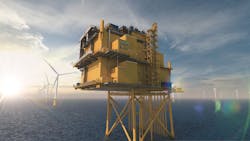Sunrise Wind to use HVDC transmission technology
Offshore staff
MUNICH, Germany – Ørsted and Eversource have selected the Siemens Energy and Aker Solutions consortium to supply the high-voltage direct current (HVDC) transmission system for Sunrise Wind, New York’s first utility-scale offshore wind project.
Siemens Energy will deliver the HVDC system on a turnkey basis and provide onshore civil work in partnership with local companies. The HVDC system will enable the low-loss transport of the generated green energy from the offshore wind farm to the mainland. It consists of two converter stations.
The offshore converter station will collect the 66 kilovolts (kV) alternating current (AC) power generated by the wind turbines through an inter-array cable system and transform it to 320 kV DC for transmission through a 160-km (99-mi) export cable to the onshore converter station in Holbrook on Long Island. The onshore station will convert the power back to AC to feed it into the distribution grid which will bring the energy to end users in New York.
Aker Solutions is responsible for the offshore converter platform, which will consist of a steel jacket and a topsides platform deck housing the electrical equipment.
The onshore converter station will be installed by local companies.
The final deliveries are scheduled for the second half of 2025.
Located about 50 km (30 mi) east of Long Island, the 924-MW Sunrise Wind project is expected to power nearly 600,000 homes in New York and be operational in 2025.
This is Siemens Energy’s first offshore grid connection project in the US.
According to Ørsted, Sunrise Wind will be the first offshore wind project in the US to use HVDC transmission technology. HVDC technology offers advantages over AC technology in electricity transmission over long distances. HVDC reduces the number of cables, improves transmission efficiency (e.g., reduces energy lost during transmission), and eliminates the need for additional electrical equipment between offshore and onshore converter terminals.
10/27/2021

